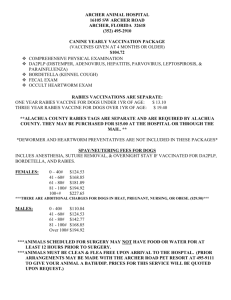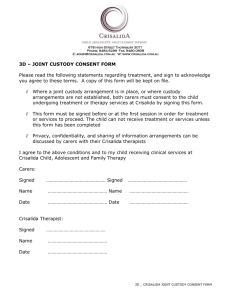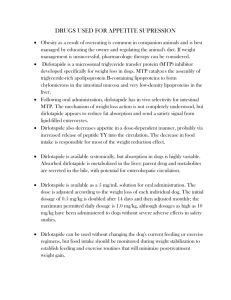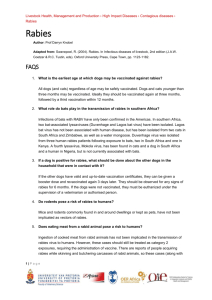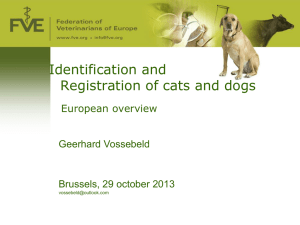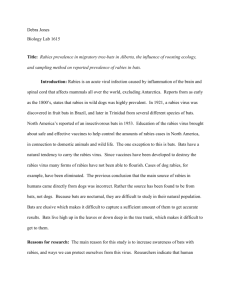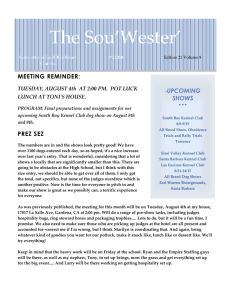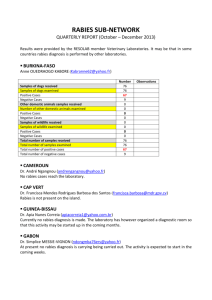Guideline example for Animals in Schools
advertisement
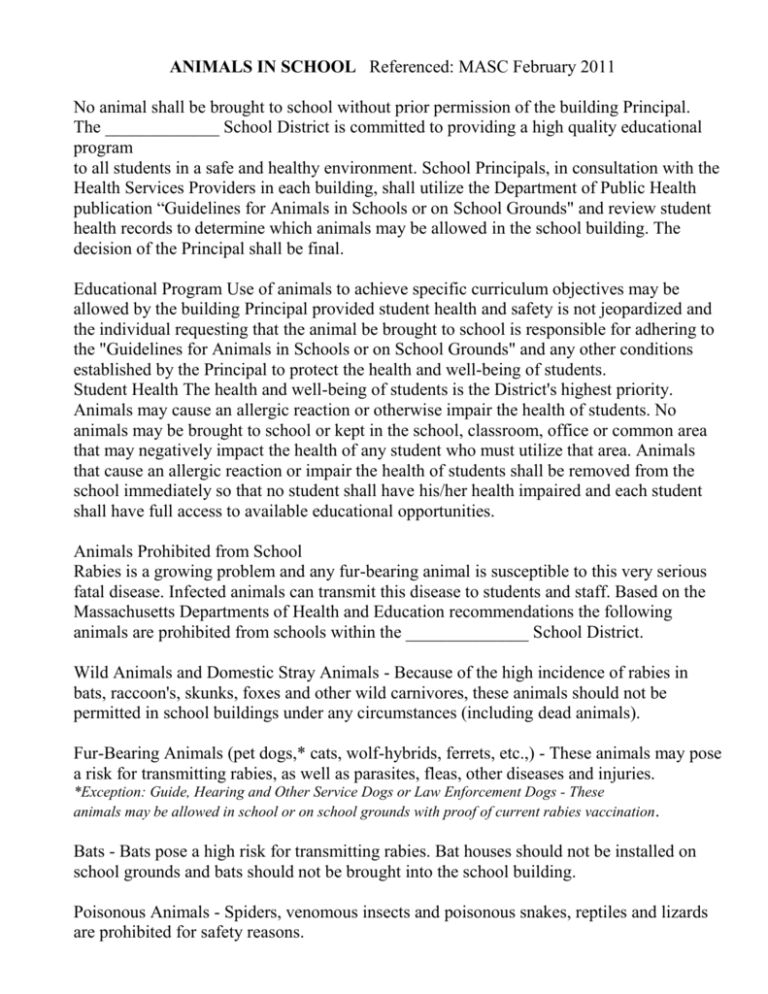
ANIMALS IN SCHOOL Referenced: MASC February 2011 No animal shall be brought to school without prior permission of the building Principal. The _____________ School District is committed to providing a high quality educational program to all students in a safe and healthy environment. School Principals, in consultation with the Health Services Providers in each building, shall utilize the Department of Public Health publication “Guidelines for Animals in Schools or on School Grounds" and review student health records to determine which animals may be allowed in the school building. The decision of the Principal shall be final. Educational Program Use of animals to achieve specific curriculum objectives may be allowed by the building Principal provided student health and safety is not jeopardized and the individual requesting that the animal be brought to school is responsible for adhering to the "Guidelines for Animals in Schools or on School Grounds" and any other conditions established by the Principal to protect the health and well-being of students. Student Health The health and well-being of students is the District's highest priority. Animals may cause an allergic reaction or otherwise impair the health of students. No animals may be brought to school or kept in the school, classroom, office or common area that may negatively impact the health of any student who must utilize that area. Animals that cause an allergic reaction or impair the health of students shall be removed from the school immediately so that no student shall have his/her health impaired and each student shall have full access to available educational opportunities. Animals Prohibited from School Rabies is a growing problem and any fur-bearing animal is susceptible to this very serious fatal disease. Infected animals can transmit this disease to students and staff. Based on the Massachusetts Departments of Health and Education recommendations the following animals are prohibited from schools within the ______________ School District. Wild Animals and Domestic Stray Animals - Because of the high incidence of rabies in bats, raccoon's, skunks, foxes and other wild carnivores, these animals should not be permitted in school buildings under any circumstances (including dead animals). Fur-Bearing Animals (pet dogs,* cats, wolf-hybrids, ferrets, etc.,) - These animals may pose a risk for transmitting rabies, as well as parasites, fleas, other diseases and injuries. *Exception: Guide, Hearing and Other Service Dogs or Law Enforcement Dogs - These animals may be allowed in school or on school grounds with proof of current rabies vaccination. Bats - Bats pose a high risk for transmitting rabies. Bat houses should not be installed on school grounds and bats should not be brought into the school building. Poisonous Animals - Spiders, venomous insects and poisonous snakes, reptiles and lizards are prohibited for safety reasons. Exceptions may be made with the prior approval of the Superintendent of Schools. Service Animals (Guide or Assistance Dogs) The ______________ School Committee does not permit discrimination against individuals with disabilities, including those who require the assistance of a service animal. The District will comply with Massachusetts law concerning the rights of persons with guide or assistance dogs and with federal law and will permit such animals on school premises and on school transportation. For purposes of this policy, a “service animal includes any dog that has been individually trained to do the work or perform tasks for the benefit of an individual with a disability.” The regulations further state that “a public entity shall make reasonable modifications in policies, practices, or procedures to permit the use of a miniature horse by an individual with a disability if the horse has been individually trained to do work or perform tasks for the benefit of the individual with the disability.” Service animals perform some of the functions and tasks that individuals with disabilities cannot perform themselves. Service animals are not pets. There are several kinds of service animals that assist individuals with disabilities. Examples include, but are not limited to, animals that: assist individuals who are blind or have severe sight impairments as“seeing eye dogs” or “guide dogs;” alert individuals with hearing impairments to sounds; pull wheelchairs or carry and pick-up items for individuals with mobility impairments; and assist mobility-impaired individuals with balance. The District shall not assume or take custody or control of, or responsibility for, any service animal or the care or feeding thereof. The owner or person having custody and control of the animal shall be liable for any damage to persons, premises, property, or facilities caused by the service animal, including, but not limited to, clean up, stain removal, etc. If, in the opinion of the School Principal or authorized designee, any service animal is not in the control of its handler, or if it is not housebroken, the service animal may be excluded from the school or program. The service animal can also be excluded if it presents a direct and immediate threat to others in the school. The parent or guardian of the student having custody and control of the animal will be required to remove the service animal from District premises immediately. If any student or staff member assigned to the classroom in which a service animal is permitted suffers an allergic reaction to the animal, the person having custody and control of the animal will be required to remove the animal to a different location designated by the Building Principal or designee and an alternative plan will be developed with appropriate District staff. Such plan could include the reassignment of the person having custody and control of the animal to a different classroom. This will also apply if an individual on school transportation suffers an allergic reaction. In this case, an alternate plan will be developed in coordination with appropriate school, District, and transportation staff including the involvement of the parents/guardian of the student. When a student will be accompanied by a service animal at school or in other District facilities on a regular basis, such staff member or such student’s parent or guardian, as well as the animal’s owner and any other person who will have custody and control of the animal will be required to sign a document stating that they have read and understood the foregoing. The Superintendent of Schools or his/her designee shall be responsible for developing procedures to accommodate a student’s use of an assistance animal in District facilities and on school transportation vehicles. Referenced: MASC February 2011 Massachusetts Laws for service animals http://www.mass.gov/courts/case-legal-res/law-lib/laws-by-subj/about/serviceanimals.html
